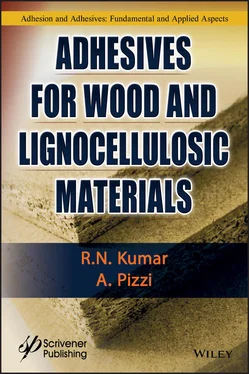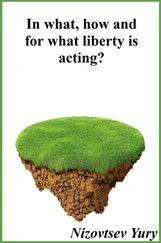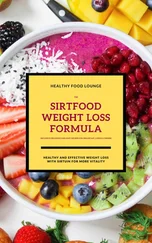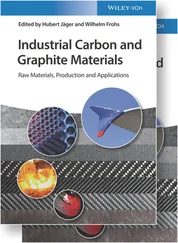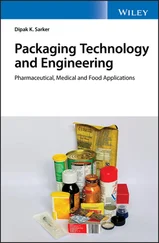5 Index
6 End User License Agreement
1 Cover
2 Table of Contents
3 Begin Reading
1 Preface Figure 1Basic wood elements from largest to smallest (i.e., breakdown of solid wood into…
2 Chapter 1 Figure 1.1Earlywood and latewood [5]. Figure 1.2Schematic model of the cell wall layers [16]. Figure 1.3Chemical composition of wood. Figure 1.4The three monolignols. Figure 1.5Radicals and units—nomenclature. Figure 1.6Various degradation products of lignin. Figure 1.7Enzymatic dehydrogenation of coniferyl alcohol yielding phenoxy radicals. Figure 1.8Typical dilignol structures [25]. Figure 1.9Arrays of cells aligned along the longitudinal and radial directions.
3 Chapter 2 Figure 2.1Potential energy diagram for different forces [4]. Figure 2.2Various wood elements. Figure 2.3Wetting phenomenon. Figure 2.4Wetting, spreading, and dewetting for different contact angles. Figure 2.5Equilibrium contact angle based on balance of forces. Figure 2.6Zisman’s plot… Figure 2.7Different links in adhesive bonding.
4 Chapter 3 Figure 3.1Reaction between urea and formaldehyde: mononuclear methylol ureas. Figure 3.2Reaction mechanism. Figure 3.3Effect of pH on the rate of addition and condensation reactions [24]. Figure 3.4Reaction chemistry. Figure 3.5Reaction mechanism for chain extension. Figure 3.6Monomeric species. Figure 3.7Oligomeric species. Figure 3.8General chemical structure of commercial UF resin. Figure 3.9Cross-linked structure of cured UF resin. Figure 3.10Synthesis of PILs. Figure 3.11Structure of polyamines.
5 Chapter 4 Figure 4.1Ammeline, ammelide, and cyanuric acid.
6 Chapter 5 Figure 5.1Resol, resitol, and resite. Figure 5.2Resonance structures of phenol. Figure 5.3Formation of ortho-methylolphenol. Figure 5.4Mononuclear phenol alcohols. Figure 5.5Mechanism of methylolphenol formation in alkaline medium. Figure 5.6Chain extension. Figure 5.7A dinuclear structure. Figure 5.8Formation of quinine–methide as intermediate. Figure 5.9Typical structure of a commercial phenolic resol. Figure 5.10Structure of ammonia-catalyzed resol. Figure 5.11Three-dimensional response surface relating the heat of P–F condensation… Figure 5.12Interaction of resin synthesis, structure, and property relationships [36].
7 Chapter 6 Figure 6.1Reaction of resorcinol with formaldehyde through its different methylol derivatives… Figure 6.2Possible quinone methide intermediates formed by reaction of resorcinol with… Figure 6.3Reaction of resorcinol with formaldehde to form HMR trimer.
8 Chapter 7 Figure 7.1Isocyanurate and allophenate. Figure 7.2Aliphatic isocyanates. Figure 7.3Biuret of HDI. Figure 7.4TDIs 2,4 and 2,6 isomers (65:35). Figure 7.5TDIs 2,4 and 2,6 isomers (80:20). Figure 7.6Polymeric MDI. Figure 7.7Catalysts for reactions of isocyanates. Figure 7.8Multiple pathways for the formation of a wood/isocyanate adhesive bond. Figure 7.9MDI reaction with wood hydroxyls. Figure 7.10Schematic reaction of formation of a PU from a polyisocianate and a polyol. Figure 7.11“Green” pressure-sensitive PU adhesive prepared from glycerol and… Figure 7.12Reaction of P. pinaster bark tannin with propylene oxide to produce… Figure 7.13Formation of PU adhesive and resins by reaction of a hydroxypropylated polypheno… Figure 7.14Reaction of the flavonoid tannin/formaldehyde system with isocyanates to form… Figure 7.15Formation of PU by reaction of a glyoxalated flavonoid tannin with a polyisocyan… Figure 7.16Non-isocyanate PU formation by reaction of a dicyclic organic carbonate with a… Figure 7.17Non-isocyanate diurethane obtained by reacting a precarbonated flavonoid tannin… Figure 7.18Non-isocyanate urethane bridge linking a precarbonated flavonoid tannin dimer… Figure 7.19Non-isocyanate diurethane obtained by reaction of a carbonated carbohydrate… Figure 7.20Non-isocyanate diurethane obtained by reaction of a carbonated carbohydrate… Figure 7.21Examples of linear and branched oligomer structures identified for glucose-based…
9 Chapter 10 Figure 10.1Hydrophobization of wood. Figure 10.2Sol-gel reaction scheme.
10 Chapter 11 Figure 11.1MALDI mass spectrum of (a) natural mimosa tannin extract. (b) Details of the 600… Scheme 11.1
11 Chapter 12 Figure 12.1Schematic representation of the decomposition of hexamine to iminoamino methylen… Figure 12.2Dry IB strength as a function of tannin solution pH of laboratory particleboards… Figure 12.3Dry IB strength of laboratory particleboards prepared with mixtures of different… Figure 12.4Chemical composition and type of compounds in CNSL. Figure 12.5Ozonolysis of CNSL to produce cardanolaldehyde and a hydroperoxide, the latter… Figure 12.6Example of the relative movement of two pieces of wood during wood welding witho…
12 Chapter 13 Figure 13.1Susceptible bonds in UF. Figure 13.2Susceptible bonds in MF and PF. Figure 13.3Reaction between chromotropic acid and formaldehyde. Figure 13.4Emission according to gas analysis. Figure 13.5Test apparatus for the flask method. Figure 13.6Reaction between acetylacetone and formaldehyde. Figure 13.7Japanese desiccator method. Figure 13.8The perforator method.
13 Chapter 14 Figure 14.1Viscous flow between two parallel plates. Figure 14.2Ostwald’s viscometer. Figure 14.3Ford cup. Figure 14.4Non-Newtoninan fluids. Figure 14.5Maxwell element. Figure 14.6Voigt element. Figure 14.7Maxwell-Voigt mixed model. Figure 14.8Macroscopic development of rheological and mechanical properties during network… Figure 14.9Response of elastic and viscous materials to sinusoidal stresses. Figure 14.10Strain response to sinusoidal stress. Figure 14.11Graphical representation of storage and loss moduli (Argand diagram). Figure 14.12Significance of elastic response and energy loss. Figure 14.13Details of a TTT diagram of an epoxy resin adhesive on a non-interacting glass… Figure 14.14Generalized TTT diagram of water-carried PF resin adhesives on an interacting… Figure 14.15Generalized CHT diagram of water-carried PF resin adhesives on an interacting… Figure 14.16TMA curve of the hardening of a PF resin in situ in a beech wood joint… Figure 14.17Wire mesh geometry. Figure 14.18Sample configuration for the DMTA (three-point bending mode) test.
Читать дальше
